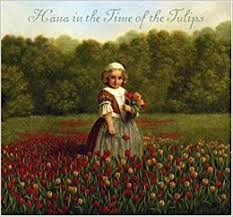Hana in the Time of the Tulips
Listen to the Recess! Clip
| Author | John Cech |
| Air Date | 5/2/2005 |

Hana in the Time of the Tulips Transcript
It’s the first days of May, a time when things suddenly begin to bloom in northern climates, a time for flowers. The ancient Romans even held a festival in the early part of May in honor of Flora, the Goddess of all blooming things.
In Holland during the 1630s, one of the most valuable possessions you could own was a tulip bulb. From 1634 until 1637, when Tulipomania swept through the Netherlands, tulips were more than a mere fad: they were probably the most expensive thing on the planet. One single, rare tulip bulb, Deborah Noyes tells us, might fetch the price “of a fancy townhouse.” Ms. Noyes is the author of a new picture book about this phenomenon: Hana in the Time of the Tulips, with illustrations by Bagram Ibatoulline. Unfolding like a portfolio of Dutch Master drawings and paintings, with their captions, this quiet though compelling book relates the story of one family’s bitter-sweet encounter with these flowers — which derived their name from the Turkish word, tulibend, which means “turban.”
Hanna is a joyful, soulful little girl, the delight of her merchant father’s eye — except when he’s thinking of the tulips that he trades and that, in the greed that has overtaken him, he can’t seem to get enough of. They are his obsession, and this has Hanna worried. Though he has made a fortune on tulips, he has become moody and distant. She tries to play doctor to her father, like their family friend, Dr. de Passe. She is looking for a medicine “to keep away dark thoughts.”One of the prescriptions that Hana thinks will cheer her father up is a glowing handful of fireflies that her nurse shows her, in one of Ibatoulline’s remarkable pictures, their iridescence radiating from the Nurse’s cupped palms and gently suffusing Hanna’s face with their light. Walking through the rooms and gardens of Hanna’s world is as though we’ve stepped into the paintings of Vermeer and Rembrandt, with their stunning perspectives, their dramatic illuminations, their hushed but still powerful sense of narrative detail. As it happens, Rembrandt is also a family friend and has even given Hanna some drawing lessons, along with some advice: “Seeing is more than looking, “he tells her, when she complains of being bored with his assignment to her — to draw eyes. And, slowly, quietly, as the story makes its way through the collapse of her family’s fortune, and the promise of a new beginning — we see how Hana takes this lesson to heart. Hana in the Time of the Tulips is a unique picture book; it’s as exquisitely wrought and rare as one of those flowers that once overwhelmed people’s senses and and made them lose their way– and as rare and sweet as the child’s spirit that helps them find the way back home again.